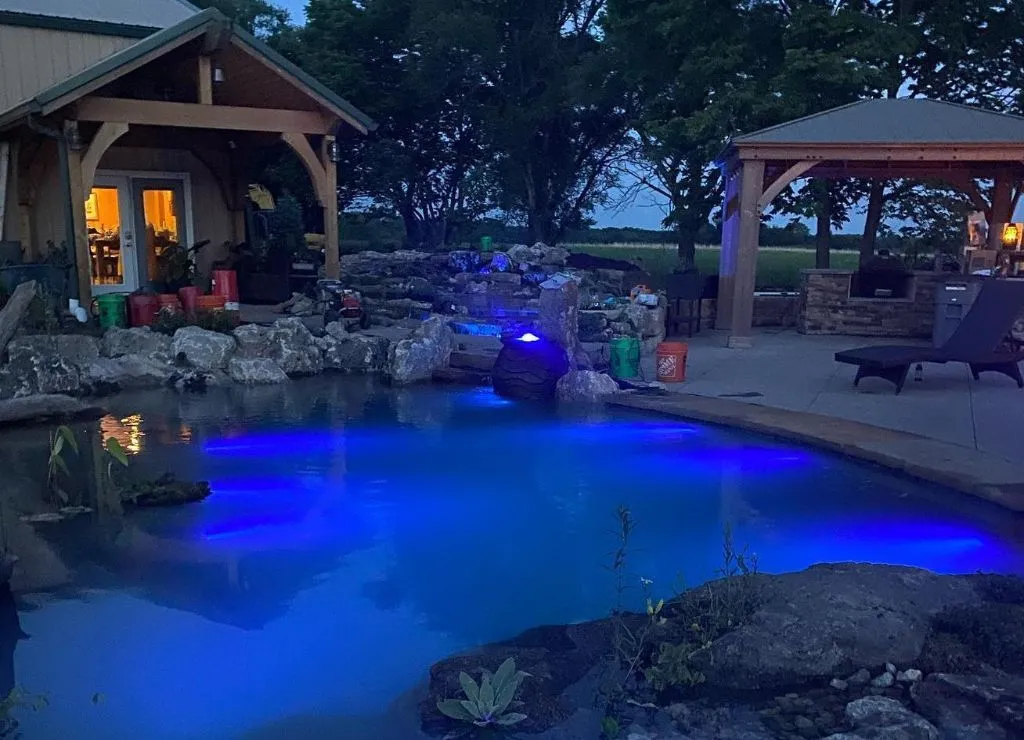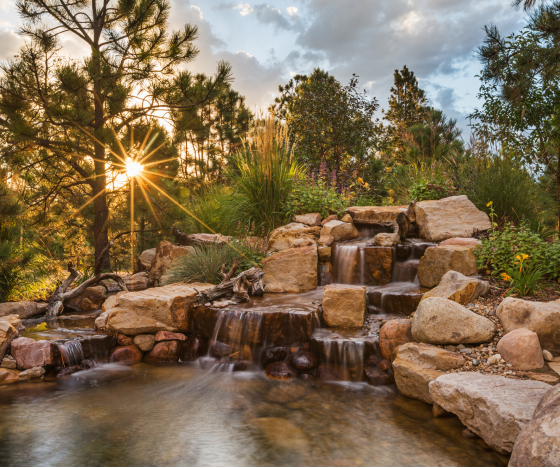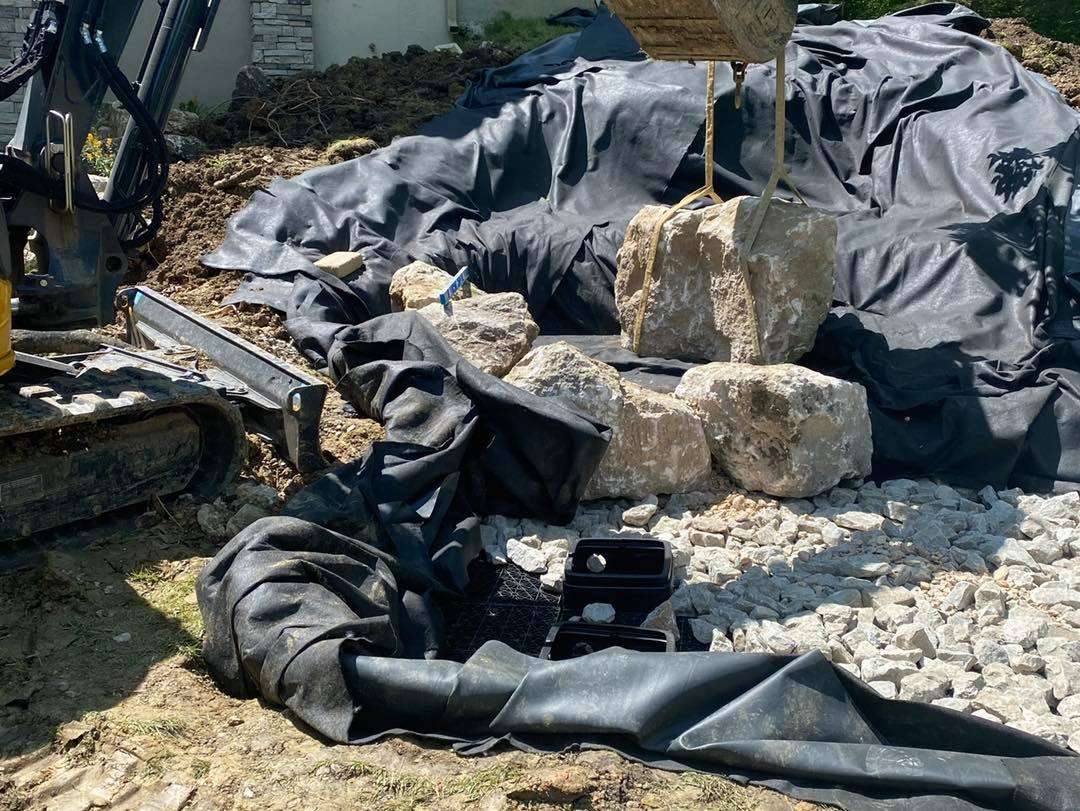
A koi pond is more than just a pool of water—it’s a unique and serene piece of living art. Just as with any work of art, proper lighting is essential to bring out the beauty of your koi pond and create the perfect ambiance for relaxation. This is where pond lighting comes into play.
With so many different types, styles, and materials of pond lights available on the market, it can be difficult to know where to begin.
But fear not! This guide will teach you the basics of what you need to know about pond lighting, from the different types of fixtures available to the Kelvin temperature and beam angles that will best show off your koi pond. By the time you’re finished reading, you’ll know more about how to create a tranquil oasis in your backyard.
Types Of Pond Lights
Underwater Pond Lights
Underwater pond lights are designed to be placed underneath the waterline. Underwater lighting is an excellent choice if you want to highlight specific features of your backyard pond, such as a waterfall or fountain.
Submersible pond lights are available in a wide variety of materials, including stainless steel, brass, ceramic, aluminum, composite, and more. When choosing underwater fixtures, be sure to select ones that are resistant to corrosion and designed for use in wet environments.
Do not use copper lights underwater! It can be dangerous for any fish and plants.
Above-Water Pond Lights
Above-water pond lights are placed outside of the waterline and can be used to highlight different areas around your koi pond. Above-water fixtures are available in wall-mounted, post-mounted, and hanging styles.
If you choose a wall-mounted or post-mounted light fixture, be sure that it is made from weather-resistant materials such as stainless steel or aluminum so that it can withstand the elements.
Hanging above-water fixtures are another popular option for koi ponds. These fixtures can be suspended from tree branches or other overhead structures using hooks or chains.
When selecting an above-water hanging fixture, look for one that has an adjustable chain or cord so that you can customize the height of the fixture to suit your needs.
Floating Pond Lights
Floating pond lights are designed to float on the surface of the water and provide ambient lighting for your koi pond. Floating lights are available in a wide variety of styles and colors so that you can create the perfect look for your space.
In addition to traditional round floating lights, you can also find floating lights shaped like lotus flowers, lilies, stars, and more. Many floating lights also come with remote controls so that you can turn them on and off without having to get into the water.
Pond Lighting Effects

Think about what parts of your koi pond you want lit and why. This includes underwater, behind waterfalls, over the water, and around the sides.
Placing submersible lights underneath a waterfall or fountain will create a stunning underwater light show as the water cascades over the illuminated rocks or other features. You can also use submersible lights to create glowing effects in ornamental fish ponds by placing them inside glass balls or other translucent objects.
Place downlights in a tree above your koi pond to create a moon lighting effect. It can look like the moon is shining in your koi pond every night!
Putting lights along the edges does two things. It brightens up the area around your pond so you and others can enjoy the plants along the side. This also shows people where the pond is so they don’t accidentally step into it.
What to Consider When Designing Your Pond Lighting Scheme

Now that you know about the different types of fixtures available for use in ponds, it’s time to start thinking about how to design your own unique pond lighting scheme.
There are several factors that you’ll need to take into consideration when designing your pond lighting.
Current Landscape Lighting
You’ll want to make sure any water feature lights don’t contrast with any current landscape lighting you have. Also, make sure you don’t use so many lights that you end up whitewashing your yard. This means it’s so lit that it doesn’t have any visual appeal to it. The interplay of light and shadow creates a more beautiful and interesting effect. An outdoor lighting guide can help round out your knowledge so you can create a better lighting design.
How Many Lights Do I Need For My Koi Pond?
This will depend on the size of your pond, but as a general rule of thumb, you should have one light for every 10 square feet of surface area. So if your pond is 100 square feet, you would need 10 lights.
Kelvin Temperature Of The Light Bulbs
Kelvin temperature is a measure of the color of light. It’s represented by a unit of measurement called Kelvin (K). The lower the Kelvin number, the warmer the light. For example, candlelight has a Kelvin temperature of about 2,000K. Sunlight has a Kelvin temperature of about 6,000K.
You might be wondering why Kelvin temperature is important when it comes to pond lights. The answer is that different color temperatures can have different effects on fish. For example, warm light (2,000K to 3,000K) can be calming for fish, while cool light (4,000K to 5,000K) can be energizing. If you want to create a relaxing environment for your koi, then you’ll want to choose pond lights with a lower Kelvin temperature. If you’re looking to showcase your koi in all their glory, then you might want to go with a higher Kelvin temperature.
Kelvin temperatures between 2,700 and 3,500 tend to show off koi fish the best.
Beam Angle Of The Fixtures
The beam angle is the angle at which light is emitted from a light source. When choosing pond lights, it’s important to consider the beam angle because it will affect how much light is distributed throughout your pond.
A wider beam angle will distribute light more evenly and will also create a more natural look since sunlight has a very wide beam angle. A narrower beam angle will concentrate the light in a smaller area. Therefore, if you have a small pond, you may want to choose lights with a narrower beam angle so that more light reaches the bottom of the pond where your koi are.
You also need to be mindful of your neighbors. The wrong beam angle can shine a light on or even into their homes.
The 3 Types Of Light Bulbs For Ponds

LED lights are the most energy-efficient option and they last the longest of any type of light bulb. They also don’t produce as much heat as other types of bulbs, making them a safer option if you have kids or pets who like to play near the pond. The downside to LED lights is that they can be more expensive than other types of bulbs.
Halogen lights are a popular choice for ponds because they’re bright and they cast a wide beam of light. Halogen bulbs also don’t get as hot as incandescent bulbs, making them a safer option if you have kids or pets who like to play near the pond. The downside to halogen lights is that they’re not as energy-efficient as LED lights and they don’t last as long.
Incandescent bulbs are the least expensive option, but they’re not as energy-efficient as LED or halogen bulbs. They also give off more heat than other types of bulbs, so they’re not ideal if you have kids or pets who like to play near the pond. However, incandescent bulbs provide a warm glow that some people prefer for their koi ponds.
Light Bulb Wattage And Lumens
The best wattage for pond lights ranges from about 10 to 20 watts. For lumens, which are for LED bulbs, the range is 200 to 400 lumens.
Transformer Type
Pond lights usually require a transformer to convert AC current into DC current. When choosing a transformer, be sure to select one that is specifically designed for use with pond lights. Make sure that the transformer can handle the number of watts required by all of the bulbs in your system.
Gradex Company Can Help Light Your Pond And More
Pond lighting is a great way to improve the appearance of your pond and increase its usability at night. By understanding the different types of pond lights and their effects, you can select the best type of light for your specific needs. With the right light bulbs, you can enjoy your pond well into the evening hours.
Have you decided on the perfect type of pond light? If not, fill out our contact form today and let us help you choose the perfect light for your needs. We would be happy to discuss lighting options with you and provide advice on how to create a beautiful and functional pond lighting design.



